A Scoping Review of Social Determinants of Health and Pain Outcomes in Sickle Cell Disease
IF 1.6
4区 医学
Q2 NURSING
引用次数: 0
Abstract
Background
Sickle cell disease (SCD) is a hereditary blood disorder with chronic pain that affects over 100,000 people in the United States. Previous research suggests a complex interaction between SCD pain outcomes and social determinants of health (SDOH).
Objective
To explore the impact of SDOH on pain outcomes in SCD.
Design
We used a scoping review design to explore the broad topic of social factors that affect SCD pain.
Data Sources
We searched the PubMed/MEDLINE, CINAHL, and Embase databases using combined search and Medical Subject Headings terms (“social determinants of health,” “sickle cell,” and “pain”).
Review Methods
We used a content analysis with a summative approach to identify and describe interactions between SDOH and SCD pain outcomes.
Findings
Eight articles reporting studies with 7,992 total participants and a focus on SCD pain outcomes met the inclusion criteria. Three themes related to SDOH and pain were produced: education and employment, social and emotional functioning, and healthcare access.
Conclusion
The key findings highlight the complex interplay between socioeconomic, psychological, and biological factors in SCD pain experiences. This underscores the need for nursing care to consider SDOH in an integrated, holistic approach to SCD pain.
Implications for Nursing
To improve pain management among their SCD patients, nurses can assess pain holistically, develop customized individual pain management plans with educational and health literacy support options, and strengthen social support.
镰状细胞病健康和疼痛结果的社会决定因素范围综述。
背景:镰状细胞病(SCD)是一种伴有慢性疼痛的遗传性血液疾病,美国有超过 10 万人患有该病。先前的研究表明,SCD 疼痛结果与健康的社会决定因素(SDOH)之间存在复杂的相互作用:探索 SDOH 对 SCD 疼痛结果的影响:设计:我们采用范围综述设计来探讨影响 SCD 疼痛的社会因素这一广泛主题:我们使用联合检索和医学主题词("健康的社会决定因素"、"镰状细胞 "和 "疼痛")检索了 PubMed/MEDLINE、CINAHL 和 Embase 数据库:综述方法:我们采用总结性的内容分析法来识别和描述 SDOH 与 SCD 疼痛结果之间的相互作用:八篇报告研究的文章符合纳入标准,总参与人数达 7992 人,重点关注 SCD 疼痛结果。得出了与 SDOH 和疼痛相关的三个主题:教育和就业、社会和情感功能以及医疗保健:主要研究结果强调了 SCD 疼痛经历中社会经济、心理和生物因素之间复杂的相互作用。结论:主要研究结果强调了社会经济、心理和生物因素在 SCD 疼痛经历中的复杂相互作用,这突出了护理工作需要在综合、全面的 SCD 疼痛治疗方法中考虑 SDOH:为了改善 SCD 患者的疼痛管理,护士可以全面评估疼痛,制定具有教育和健康知识支持选项的个性化疼痛管理计划,并加强社会支持。
本文章由计算机程序翻译,如有差异,请以英文原文为准。
求助全文
约1分钟内获得全文
求助全文
来源期刊

Pain Management Nursing
医学-护理
CiteScore
3.00
自引率
5.90%
发文量
187
审稿时长
>12 weeks
期刊介绍:
This peer-reviewed journal offers a unique focus on the realm of pain management as it applies to nursing. Original and review articles from experts in the field offer key insights in the areas of clinical practice, advocacy, education, administration, and research. Additional features include practice guidelines and pharmacology updates.
 求助内容:
求助内容: 应助结果提醒方式:
应助结果提醒方式:


